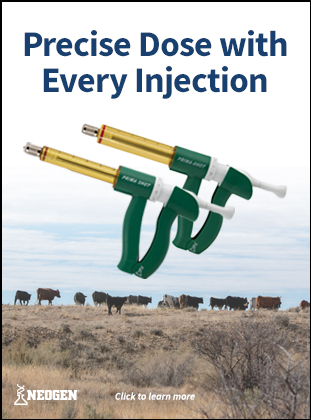Remove the guesswork from choosing the best fly control for cattle

Remove the guesswork from choosing the best fly control for cattle
Use these tips to sift through fly control options for cattle on pasture.
Article and photos courtesy of Purina Animal Nutrition LLC
Arden Hills, Minn. [March 27, 2024] – Pesky horn flies can become prolific during the grazing season. However, there are control tactics that can help keep horn fly populations under wraps.
When uncontrolled, horn flies can punish cattle with as many as 120,000 bites per day. During peak timeframes, as many as 4,000 horn flies can call a cow’s hide home. At 30 blood meals daily, that adds up to 120,000 bites per cow. These bites are not only irritating your cows, but they’re also biting away at your potential profits. Horn flies account for up to an estimated $1 billion in losses annually for the U.S. cattle industry.[1]
“Early season fly control for cattle goes a long way in keeping populations under control all season long,” says Elizabeth Belew, Ph.D., cattle nutritionist with Purina Animal Nutrition.
Consider these four methods of fly control as you turn cattle out onto spring pasture:
1. Feed-through
An effective and convenient way to deliver horn fly control for cattle throughout fly season is by feeding a mineral containing an insect growth regulator (IGR).
A feed-through mineral is an excellent option for all classes of cattle out on pasture because they regularly consume a quality mineral to meet their nutrient needs.
“As cattle consume mineral with IGR, it passes through the animal and into fresh manure, where female adult horn flies lay their eggs,” says Belew. “The IGR prevents pupae from developing into biting adult flies.”
For best results, feed 30 days before the last frost of spring through 30 days after the first frost in the fall.
“Ensure cattle are consuming mineral at target levels,” says Belew. “Appropriate mineral intake ensures cattle get the targeted level of IGR, which helps them receive full horn fly control.”
2. Insecticide-impregnated ear tags
Ear tags containing insecticide release small amounts of chemicals over time to control flies.
“This is ideal for implementation if cattle already need to be processed for tasks like vaccinations, deworming or pregnancy checks,” says Belew.
Tags must be replaced when insecticide is depleted, usually 2–4 months after application. Using fly tags with stocker cattle can be viable because the grazing season falls within the efficacy period of the insecticide. Tags should be removed at the end of fly season.
Follow manufacturer recommendations and rotate tag insecticides as needed to mitigate fly resistance.
3. Pour-ons and on-animal sprays
“A great option for immediate fly relief is to use a pour-on or spray,” says Belew.
These liquid substances are usually applied directly on an animal’s backline. The chemical is absorbed and circulates through the animal’s system.
Pour-ons and on-animal sprays control flies for up to 30 days before requiring another application. It will require several applications to provide control all season long. You can apply pour-ons and on-animal sprays while cattle are grazing, but it works better if they are confined to a smaller area during application, like a catch pen or alley.
“This method works best as a supplemental fly control method during spikes in fly numbers,” says Belew.
4. Dust bags, backrubs and oilers
The most effective method for forced-use situations where cattle must frequently enter an area like a water or feeding site are dust bags, backrubs or oilers. A powder or liquid substance is applied with hand shakers or self-treatment dust bags.
“Using this method of fly control does require frequent device checks to keep insecticide stocked,” says Belew.
Free-choice implementation can take 2–3 weeks for cattle to adopt and might not provide equal protection throughout the herd, leaving some cattle more vulnerable. Dust bags, backrubs and oilers can better suit situations where cattle have less space to roam, such as an open lot or small grass traps.
“Other methods like baits, area and residual sprays are difficult to use in range settings and are best used in barns or a confinement setting,” says Belew.
The best way to beat the buzz?
Develop a multi-pronged fly control approach to fit your operation. Use a feed-through option like Purina® Wind and Rain® Fly Control mineral in tandem with other fly control methods for season-long protection. Taking this type of approach can ensure fewer flies are biting into your profit while leading to better milk production and heavier weaning weights.
Not sure if fly control for cattle is really worth it? Calculate how much horn flies drain from your herd at purinamills.com/fly-control
Purina Animal Nutrition LLC (www.purinamills.com) is a national organization serving producers, animal owners and their families through more than 4,700 local cooperatives, independent dealers and other large retailers throughout the United States. Driven to unlock the greatest potential in every animal, the company is an industry-leading innovator offering a valued portfolio of complete feeds, supplements, premixes, ingredients and specialty technologies for the livestock and lifestyle animal markets. Purina Animal Nutrition LLC is headquartered in Arden Hills, Minn. and a wholly owned subsidiary of Land O’Lakes, Inc.



